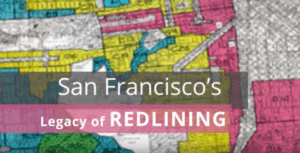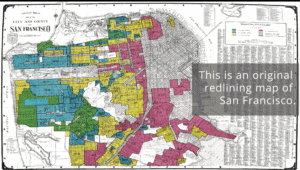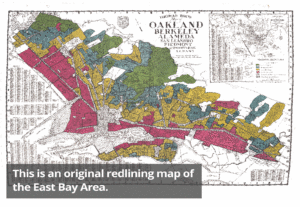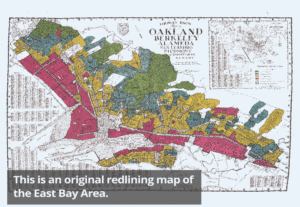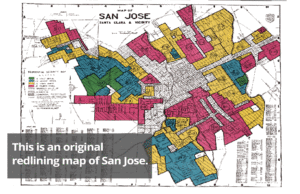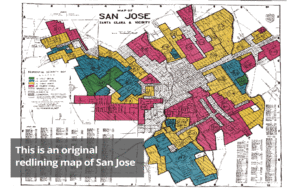Table of Contents
Videos 2-4 were created in collaboration with the San Francisco Federal Reserve Bank and the Great Communities Collaborative, an initiative of the San Francisco Foundation. Take a look at the gentrification and displacement page on the San Francisco Federal Reserve Bank’s site.
Why the Housing Crisis Needs More Solutions
Pushed Out: Displacement Today and Lasting Impacts
Mobility
A typical American moves over 11 times in their lifetime. However, we are facing an eviction epidemic. Millions of renters are currently facing evictions. In addition, Hispanic and black renters experience evictions in greater numbers than white renters.
Health Impacts
Displacement can lead to stress and depression. According to one study, the year following an eviction, mothers are 20 percent more likely to report depression than their peers. At least two years after their eviction, mothers were still experiencing significantly higher rates of depression. Furthermore, displacement can have myriad negative health impacts on children. For example, “Outcomes identified in association with frequent moves included: higher levels of behavioral and emotional problems; increased teenage pregnancy rates; accelerated initiation of illicit drug use; adolescent depression; and reduced continuity of healthcare”.
Additional Impacts of Moves on Kids
Even when kids don’t switch schools, moving around can be disruptive for academic performance. For example, moving without switching schools can still result in “severing peer networks and child care arrangements that reinforce learning and cognitive development or disruption caused by parents’ and children’s stress and anxiety related to moving”.
Neighborhood Effects
When low-income families have to leave their homes, they are likely to move to lower-income neighborhoods. Displacement to worse-off neighborhoods can intensify poverty conditions and inhibit economic mobility. Research from Philadelphia shows that moves to worse-off neighborhoods can lead to further long-term financial strain, as shown by declining credit scores for families making these moves. Living in a high poverty under-resourced neighborhood has been shown to lower children’s test scores and their earnings in adulthood. Zip code may also be more important than genetic code for life expectancy meaning that where a child is born may be a more important determinant of how long that child lives than their inherited traits.
Community Power
Staying put can enhance residents’ political power. For example, “Residents who are dispersed from other members of their community may have less political power as voting blocs are diluted and communities become less organized, inhibiting their ability to advocate for needed changes.”
No One-Size-Fits-All Solutions
Protection of residents, production of affordable housing, and preservation of existing affordable housing stock are all key pieces of preventing displacement. See our Investment without Displacement workshop series for more information.
Sources:
Chalabi, Mona (2013). “How Many Times Does the Average Person Move?”, FiveThirtyEight.
Marr, Taylor (2016). “Millions of Renters Face Evictions: Why Today’s Housing Market is Partially to Blame”, Redfin. (Note: evictions not filed through courts are not counted in the study.)
Desmond, Matthew and Tracey Shollenberger (2015). “Forced Displacement from Rental Housing: Prevalence and Neighborhood Consequences.”
Desmond, Matthew and Rachel Tolbert Kimbro (2015). “Eviction’s Fallout: Housing, Hardship, and Health.”
Jelleyman, Tim and Nicholas Spencer (2008). “Residential mobility in childhood and health outcomes: a systematic review.”
Cohen, Rebecca and Keith Wardrip (2011). “Should I Stay or Should I Go? Exploring the Effects of Housing Instability and Mobility on Children.”
Ding, Lei, Jackelyn Hwang, and Eileen Divringi (2015). “Gentrification and Residential Mobility in Philadelphia.”
Ding, Lei and Jackelyn Hwang (2016). “The Consequences of Gentrification: A Focus on Residents’ Financial Health in Philadelphia.”
Chetty, Raj and Nathaniel Hendren (2016). “The Impacts of Neighborhoods on Intergenerational Mobility I: Childhood Exposure Effects.”
Robert Wood Johnson Foundation (2015). “Short Distances to Large Gaps in Health.” (Life expectancy city maps)
The California Endowment Building Healthy Communities Initiative (2016). “A Tale of Two Zip Codes.” (Explainer video)
Causa Justa Just Cause (2014). “Development without Displacement: Resisting Gentrification in the Bay Area.” (See additional sources cited in report.)
Gentrification Explained
Gentrification: a process of neighborhood change that includes economic change in a historically disinvested neighborhood —by means of real estate investment and new higher-income residents moving in – as well as demographic change – not only in terms of income level, but also in terms of changes in the education level or racial make-up of residents.
Gentrification is complex — to understand it, there are three key things to consider:
- Historic conditions, especially policies and practices that made communities susceptible to gentrification
- Disinvestment and investment patterns of the central city taking place today as a result of these conditions.
- Impact on communities
Historic conditions:
- Redlining: From the 1930s through the late 60s, standards set by the federal government and carried out by banks explicitly labeled neighborhoods home to predominantly people of color as “risky” and “unfit for investment.” This practice meant that people of color were denied access to loans that would enable them to buy or repair homes in their neighborhood.
- White flight: Other housing and transportation policies of the mid-20th century fueled the growth of mostly white suburbs, and the exodus of capital from urban centers, in a phenomenon often referred to as “white flight.” The mortgage component of the GI Bill is an example of a program that fueled white flight. The program guaranteed low-cost mortgage loans for returning WWII soldiers. However, discrimination limited the extent to which black veterans were able to purchase homes in the growing suburbs. In fact, the FHA largely required that suburban developers agree to not sell houses to Black people in order for the developers to access these guaranteed loans.
- Urban renewal: Left behind in central city neighborhoods, low-income households and communities of color bore the brunt of highway system expansion and urban renewal programs, which resulted in the mass clearance of homes, businesses, and neighborhood institutions, and set the stage for widespread public and private disinvestment in the decades that followed.
- Foreclosure crisis: In more recent history, the foreclosure crisis contributed to making places vulnerable to gentrification. In low-income communities of color, disproportionate levels of subprime lending resulted in mass foreclosures, leaving those neighborhoods vulnerable to investors seeking to purchase and flip homes. Of foreclosures completed in 2007-2009, there were: 790 foreclosures for African-Americans, 769 foreclosures for Latinos, and 452 for Non-Hispanic Whites per 10,000 loans.
- Central city disinvestment and investment patterns: Today, both people and capital are flooding back into these historically disinvested neighborhoods. Why?
- Relative affordability
- In many US cities, the rental market has gotten increasingly expensive, and even moderate income earners are on the hunt for lower housing costs.
- For example, in San Francisco, the median rent of a typical 2BR apartment went up nearly 70% between 2011 and 2017.
- Relative affordability
- Cities tend to have older, historic housing stock that appeals to new residents.
- Cities offer proximity to commercial and job centers where jobs, restaurants and art spaces are increasingly located.
- Revitalization — cities are investing in some of these neighborhoods with improved transit access and infrastructure in part to draw in newcomers.
On the ground, gentrification may look like:
- Real estate speculation, with investors flipping properties for large profits, as well as high-end development, and landlords looking for higher-paying tenants.
- Increased investment in neighborhood amenities, like transit and parks.
- Changes in land use, for example from industrial land to restaurants and storefronts.
- Changes in the character of the neighborhood as community run businesses are replaced by businesses catering to new residents’ needs.
Impact of gentrification on communities:
While increased investment in an area can be positive, gentrification is often associated with displacement which means that in some of these communities, long-term residents are not able to stay to benefit from new investments in housing, healthy food access, or transit infrastructure. You can learn more about the forms displacement takes and its long-term impacts on families from our displacement explainer video and accompanying resources page: urbandisplacement.org/pushedout
Another impact of displacement to consider is cultural displacement. Even for long-time residents who are able to stay in newly gentrifying areas, changes in the make-up and character of a neighborhood can lead to a reduced sense of belonging, or feeling out of place in one’s own home.
What’s next?
On the whole, we cannot ignore that the adverse impacts of gentrification, ranging from individual health effects to the suburbanization of poverty, are only the most recent wave in a pattern of urban restructuring that has been imposed upon and negatively affected low income and communities of color over generations.
Public, private, and non-profit sector leaders have the opportunity to implement strategies that give long-time residents a chance to benefit from increased investment in their communities, and even be a part of driving how some of the changes in their neighborhoods take place.
Protection of residents, production of affordable housing, and preservation of existing affordable housing stock are all key pieces of preventing displacement. Check out our Investment without Displacement workshop series for more information.
Additional resources:
Read/Explore
- “The Gentrification Reader.” Lees, Loretta, and Elvin Wyly (2010).
- “Planetary Gentrification (Urban Futures).” Lees, Loretta, Hyun Bang Shin, and Ernesto López-Morales (2016).
- Check out our gentrification typology maps for Los Angeles, Portland, and – just released – the Northern California mega-region.
Listen/Watch
- There Goes the Neighborhood: Season One — a KCRW, The Nation, and WNYC Studios podcast about the gentrification of Brooklyn.
- There Goes the Neighborhood: Season Two — a KCRW, The Nation, and WNYC Studios podcast about the gentrification of Los Angeles.
- The View From Here: Place And Privilege — Capital Public Radio’s latest multimedia documentary project explores the history, politics and economics of housing affordability in Sacramento.
- City Rising — A KCET and Link TV one-hour broadcast special and multi-media project that analyzes six California communities undergoing gentrification: Boyle Heights and South Central in Los Angeles, Long Beach, Santa Ana, Oakland and the Oak Park neighborhood of Sacramento.
“Mapping Inequality: Redlining in New Deal America.” University of Richmond Digital Scholarship Lab.
“The Color of Law: A Forgotten History of How Our Government Segregated America (2017).” Rothstein, Richard.
“Crabgrass Frontier: The Suburbanization of the United States (1985).” Jackson, Kenneth T.
“60 Years of Urban Change.” Institute for Quality Communities, University of Oklahoma.
“Root shock: The consequences of African-American dispossession (2001).” Fullilove, Mindy Thompson.
“Foreclosures by Race and Ethnicity: The Demographics of a Crisis (2010).” The Center for Responsible Lending.
“The Untold Costs of Subprime Lending: Examining the Links among Higher-Priced Lending, Foreclosures and Race in California (2009).” Reid, Carolina and Elizabeth Laderman.
“Toward a Theory of Gentrification: A Back to the City Movement by Capital, Not People (1979).” Smith, Neil.
“The Rise of the Creative Class (2002).” Florida, Richard.
“Gentrification and the Rent Gap (1987).” Smith, Neil.
“Gentrification, Displacement, and the Role of Public Investment (2017).” Zuk, Miriam, Ariel Bierbaum, Karen Chapple, Karolina Gorska, and Anastasia Loukaitou-Sideris.
“Loft Conversion and Gentrification in London: From Industrial to Postindustrial Land Use (2007).” Hamnett, Chris and Drew Whitelegg.
“Transit-Oriented Development & Commercial Gentrification: Exploring the Linkages (summary) (2017).” Chapple, Karen, Anastasia Loukaitou-Sideris, et al.
“New Retail Capital and Neighborhood Change: Boutiques and Gentrification in New York City (2009).” Zukin, Sharon, et al.
“Naked City: The Death and Life of Authentic Urban Places.” Zukin, Sharon (2010).
“The back-to-the-city movement: Neighbourhood redevelopment and processes of political and cultural displacement.” Hyra, Derek (2014).
Redlining and Gentrification
Redlining was a process in which the Home Owners’ Loan Corporation (HOLC), a federal agency, gave neighborhoods ratings to guide investment. This policy is named for the practice of categorizing neighborhoods as red or “hazardous” on HOLC maps meaning that these neighborhoods were deemed the riskiest in terms of loan issuance. These neighborhoods were predominantly home to communities of color, and this is no accident; the “hazardous” rating was in large part based on racial demographics. In other words, redlining was an explicitly discriminatory policy. Redlining made it hard for residents to get loans for homeownership or maintenance, and led to cycles of disinvestment.
This history is not behind us: 87% of San Francisco’s redlined neighborhoods are low-income neighborhoods undergoing gentrification today. Watch the video to see this connection for yourself, and learn more about the lasting impacts of this discriminatory policy.
The past is embedded in the present-day experience of our neighborhoods and cities; it is important to the future of cities that we confront this history.
The Legacy of Redlining Across the Bay Area — San Francisco, East Bay, San Jose
The video above explores the overlap between redlining, gentrification, and exclusion in San Francisco, but these trends are common across the Bay Area. Take a look at the GIFs below for quick overviews of the connections between redlining, gentrification, and exclusion in San Francisco, the East Bay, and San Jose.
San Francisco – redlining and gentrification:
87% of today’s gentrifying areas in San Francisco were rated as “hazardous” (red) or “definitely declining” (yellow) by HOLC.
San Francisco – redlining and exclusion:
45% of today’s exclusionary areas in San Francisco were rated as “best” (green) or “still desirable” (blue) by HOLC.
East Bay – redlining and gentrification:
83% of today’s gentrifying areas in the East Bay were rated as “hazardous” (red) or “definitely declining” (yellow) by HOLC.
East Bay – redlining and exclusion:
75% of today’s exclusionary areas in the East Bay were rated as “best” (green) or “still desirable” (blue) by HOLC.
San Jose – redlining and gentrification:
87% of today’s gentrifying areas in San Jose were rated as “hazardous” (red) or “definitely declining” (yellow) by HOLC.
San Jose – redlining and exclusion:
59% of today’s exclusionary areas in San Jose were rated as “best” (green) or “still desirable” (blue) by HOLC.
Learn more about redlining, in your community and beyond:
Want to know how your neighborhood was rated by HOLC?
- Check out the University of Richmond’s “Mapping Inequality” Project for interactive redlining maps.
Want to understand the connection between redlining maps and other data in your community?
- The dataset from University of Richmond’s digitized maps is now on PolicyMap so that users can overlay this polygon data with a number of other layers to explore trends in residential and economic segregation, along with a host of other areas.
- Recent research from NCRC, “HOLC ‘Redlining’ Maps: The persistent structure of segregation and economic inequality,” looks at persistent impacts of redlining in cities across the US — on economic and racial segregation, inequality, and gentrification, as well as exploring regional differences.
- New maps from Wenfei Xu allow the viewer to compare different neighborhood categorizations from the redlining maps to historical US Census data, in order to better understand impacts on socioeconomic disparities and segregation.
- NPR’s recent explainer video, “Why Are Cities Still So Segregated?” teases out the connections between redlining and the landscapes of opportunity in our cities — in schools, health, wealth, policing, and more.
- Putting California redlining in context: Read about redlining and its impacts in Oakland and Los Angeles.

